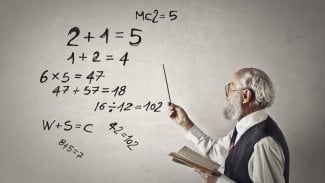sgegv
NAME
SGEGV - routine is deprecated and has been replaced by routine SGGEV
SYNOPSIS
SUBROUTINE SGEGV(
JOBVL, JOBVR, N, A, LDA, B, LDB, ALPHAR, ALPHAI,
BETA, VL, LDVL, VR, LDVR, WORK, LWORK, INFO )
CHARACTER
JOBVL, JOBVR
INTEGER
INFO, LDA, LDB, LDVL, LDVR, LWORK, N
REAL
A( LDA, * ), ALPHAI( * ), ALPHAR( * ),
B( LDB, * ), BETA( * ), VL( LDVL, * ),
VR( LDVR, * ), WORK( * )
PURPOSE
This routine is deprecated and has been replaced by routine SGGEV.
SGEGV computes for a pair of n-by-n real nonsymmetric matrices A and
B, the generalized eigenvalues (alphar +/- alphai*i, beta), and
optionally, the left and/or right generalized eigenvectors (VL and
VR).
A generalized eigenvalue for a pair of matrices (A,B) is, roughly speaking, a scalar w or a ratio alpha/beta = w, such that A - w*B is singular. It is usually represented as the pair (alpha,beta), as there is a reasonable interpretation for beta=0, and even for both being zero. A good beginning reference is the book, "Matrix Computations", by G. Golub & C. van Loan (Johns Hopkins U. Press) A right generalized eigenvector corresponding to a generalized eigenvalue w for a pair of matrices (A,B) is a vector r such that (A - w B) r = 0 . A left generalized eigenvector is a vector l such that l**H * (A - w B) = 0, where l**H is the
conjugate-transpose of l.
Note: this routine performs "full balancing" on A and B -- see "Further Details", below.
A generalized eigenvalue for a pair of matrices (A,B) is, roughly speaking, a scalar w or a ratio alpha/beta = w, such that A - w*B is singular. It is usually represented as the pair (alpha,beta), as there is a reasonable interpretation for beta=0, and even for both being zero. A good beginning reference is the book, "Matrix Computations", by G. Golub & C. van Loan (Johns Hopkins U. Press) A right generalized eigenvector corresponding to a generalized eigenvalue w for a pair of matrices (A,B) is a vector r such that (A - w B) r = 0 . A left generalized eigenvector is a vector l such that l**H * (A - w B) = 0, where l**H is the
conjugate-transpose of l.
Note: this routine performs "full balancing" on A and B -- see "Further Details", below.
ARGUMENTS
JOBVL (input) CHARACTER*1
= 'N': do not compute the left generalized eigenvectors;
= 'V': compute the left generalized eigenvectors.
= 'V': compute the left generalized eigenvectors.
JOBVR (input) CHARACTER*1
= 'N': do not compute the right generalized eigenvectors;
= 'V': compute the right generalized eigenvectors.
= 'N': do not compute the right generalized eigenvectors;
= 'V': compute the right generalized eigenvectors.
N (input) INTEGER
The order of the matrices A, B, VL, and VR. N >= 0.
A (input/output) REAL array, dimension (LDA, N)
On entry, the first of the pair of matrices whose
generalized eigenvalues and (optionally) generalized
eigenvectors are to be computed.
On exit, the contents will have been destroyed. (For a
description of the contents of A on exit, see "Further
Details", below.)
LDA (input) INTEGER
The leading dimension of A. LDA >= max(1,N).
B (input/output) REAL array, dimension (LDB, N)
On entry, the second of the pair of matrices whose
generalized eigenvalues and (optionally) generalized
eigenvectors are to be computed.
On exit, the contents will have been destroyed. (For a
description of the contents of B on exit, see "Further
Details", below.)
LDB (input) INTEGER
The leading dimension of B. LDB >= max(1,N).
ALPHAR (output) REAL array, dimension (N)
ALPHAI (output) REAL array, dimension (N)
BETA (output) REAL array, dimension (N)
On exit, (ALPHAR(j) + ALPHAI(j)*i)/BETA(j), j=1,...,N, will
be the generalized eigenvalues. If ALPHAI(j) is zero, then
the j-th eigenvalue is real; if positive, then the j-th and
(j+1)-st eigenvalues are a complex conjugate pair, with
ALPHAI(j+1) negative.
Note: the quotients ALPHAR(j)/BETA(j) and ALPHAI(j)/BETA(j)
may easily over- or underflow, and BETA(j) may even be zero.
Thus, the user should avoid naively computing the ratio
alpha/beta. However, ALPHAR and ALPHAI will be always less
than and usually comparable with norm(A) in magnitude, and
BETA always less than and usually comparable with norm(B).
VL (output) REAL array, dimension (LDVL,N)
If JOBVL = 'V', the left generalized eigenvectors. (See
"Purpose", above.) Real eigenvectors take one column,
complex take two columns, the first for the real part and
the second for the imaginary part. Complex eigenvectors
correspond to an eigenvalue with positive imaginary part.
Each eigenvector will be scaled so the largest component
will have abs(real part) + abs(imag. part) = 1, *except*
that for eigenvalues with alpha=beta=0, a zero vector will
be returned as the corresponding eigenvector.
Not referenced if JOBVL = 'N'.
LDVL (input) INTEGER
The leading dimension of the matrix VL. LDVL >= 1, and
if JOBVL = 'V', LDVL >= N.
VR (output) REAL array, dimension (LDVR,N)
If JOBVR = 'V', the right generalized eigenvectors. (See
"Purpose", above.) Real eigenvectors take one column,
complex take two columns, the first for the real part and
the second for the imaginary part. Complex eigenvectors
correspond to an eigenvalue with positive imaginary part.
Each eigenvector will be scaled so the largest component
will have abs(real part) + abs(imag. part) = 1, *except*
that for eigenvalues with alpha=beta=0, a zero vector will
be returned as the corresponding eigenvector.
Not referenced if JOBVR = 'N'.
LDVR (input) INTEGER
The leading dimension of the matrix VR. LDVR >= 1, and
if JOBVR = 'V', LDVR >= N.
WORK (workspace/output) REAL array, dimension (LWORK)
On exit, if INFO = 0, WORK(1) returns the optimal LWORK.
LWORK (input) INTEGER
The dimension of the array WORK. LWORK >= max(1,8*N).
For good performance, LWORK must generally be larger.
To compute the optimal value of LWORK, call ILAENV to get
blocksizes (for SGEQRF, SORMQR, and SORGQR.) Then compute:
NB -- MAX of the blocksizes for SGEQRF, SORMQR, and SORGQR;
The optimal LWORK is:
2*N + MAX( 6*N, N*(NB+1) ).
If LWORK = -1, then a workspace query is assumed; the routine
only calculates the optimal size of the WORK array, returns
this value as the first entry of the WORK array, and no error
message related to LWORK is issued by XERBLA.
INFO (output) INTEGER
= 0: successful exit
< 0: if INFO = -i, the i-th argument had an illegal value.
= 1,...,N: The QZ iteration failed. No eigenvectors have been calculated, but ALPHAR(j), ALPHAI(j), and BETA(j) should be correct for j=INFO+1,...,N. > N: errors that usually indicate LAPACK problems:
=N+1: error return from SGGBAL
=N+2: error return from SGEQRF
=N+3: error return from SORMQR
=N+4: error return from SORGQR
=N+5: error return from SGGHRD
=N+6: error return from SHGEQZ (other than failed iteration) =N+7: error return from STGEVC
=N+8: error return from SGGBAK (computing VL)
=N+9: error return from SGGBAK (computing VR)
=N+10: error return from SLASCL (various calls)
< 0: if INFO = -i, the i-th argument had an illegal value.
= 1,...,N: The QZ iteration failed. No eigenvectors have been calculated, but ALPHAR(j), ALPHAI(j), and BETA(j) should be correct for j=INFO+1,...,N. > N: errors that usually indicate LAPACK problems:
=N+1: error return from SGGBAL
=N+2: error return from SGEQRF
=N+3: error return from SORMQR
=N+4: error return from SORGQR
=N+5: error return from SGGHRD
=N+6: error return from SHGEQZ (other than failed iteration) =N+7: error return from STGEVC
=N+8: error return from SGGBAK (computing VL)
=N+9: error return from SGGBAK (computing VR)
=N+10: error return from SLASCL (various calls)
FURTHER DETAILS
Balancing
---------
This driver calls SGGBAL to both permute and scale rows and columns of A and B. The permutations PL and PR are chosen so that PL*A*PR and PL*B*R will be upper triangular except for the diagonal blocks A(i:j,i:j) and B(i:j,i:j), with i and j as close together as possible. The diagonal scaling matrices DL and DR are chosen so that the pair DL*PL*A*PR*DR, DL*PL*B*PR*DR have elements close to one (except for the elements that start out zero.)
After the eigenvalues and eigenvectors of the balanced matrices have been computed, SGGBAK transforms the eigenvectors back to what they would have been (in perfect arithmetic) if they had not been balanced.
Contents of A and B on Exit
-------- -- - --- - -- ----
If any eigenvectors are computed (either JOBVL='V' or JOBVR='V' or both), then on exit the arrays A and B will contain the real Schur form[*] of the "balanced" versions of A and B. If no eigenvectors are computed, then only the diagonal blocks will be correct. [*] See SHGEQZ, SGEGS, or read the book "Matrix Computations", by Golub & van Loan, pub. by Johns Hopkins U. Press.
---------
This driver calls SGGBAL to both permute and scale rows and columns of A and B. The permutations PL and PR are chosen so that PL*A*PR and PL*B*R will be upper triangular except for the diagonal blocks A(i:j,i:j) and B(i:j,i:j), with i and j as close together as possible. The diagonal scaling matrices DL and DR are chosen so that the pair DL*PL*A*PR*DR, DL*PL*B*PR*DR have elements close to one (except for the elements that start out zero.)
After the eigenvalues and eigenvectors of the balanced matrices have been computed, SGGBAK transforms the eigenvectors back to what they would have been (in perfect arithmetic) if they had not been balanced.
Contents of A and B on Exit
-------- -- - --- - -- ----
If any eigenvectors are computed (either JOBVL='V' or JOBVR='V' or both), then on exit the arrays A and B will contain the real Schur form[*] of the "balanced" versions of A and B. If no eigenvectors are computed, then only the diagonal blocks will be correct. [*] See SHGEQZ, SGEGS, or read the book "Matrix Computations", by Golub & van Loan, pub. by Johns Hopkins U. Press.



















